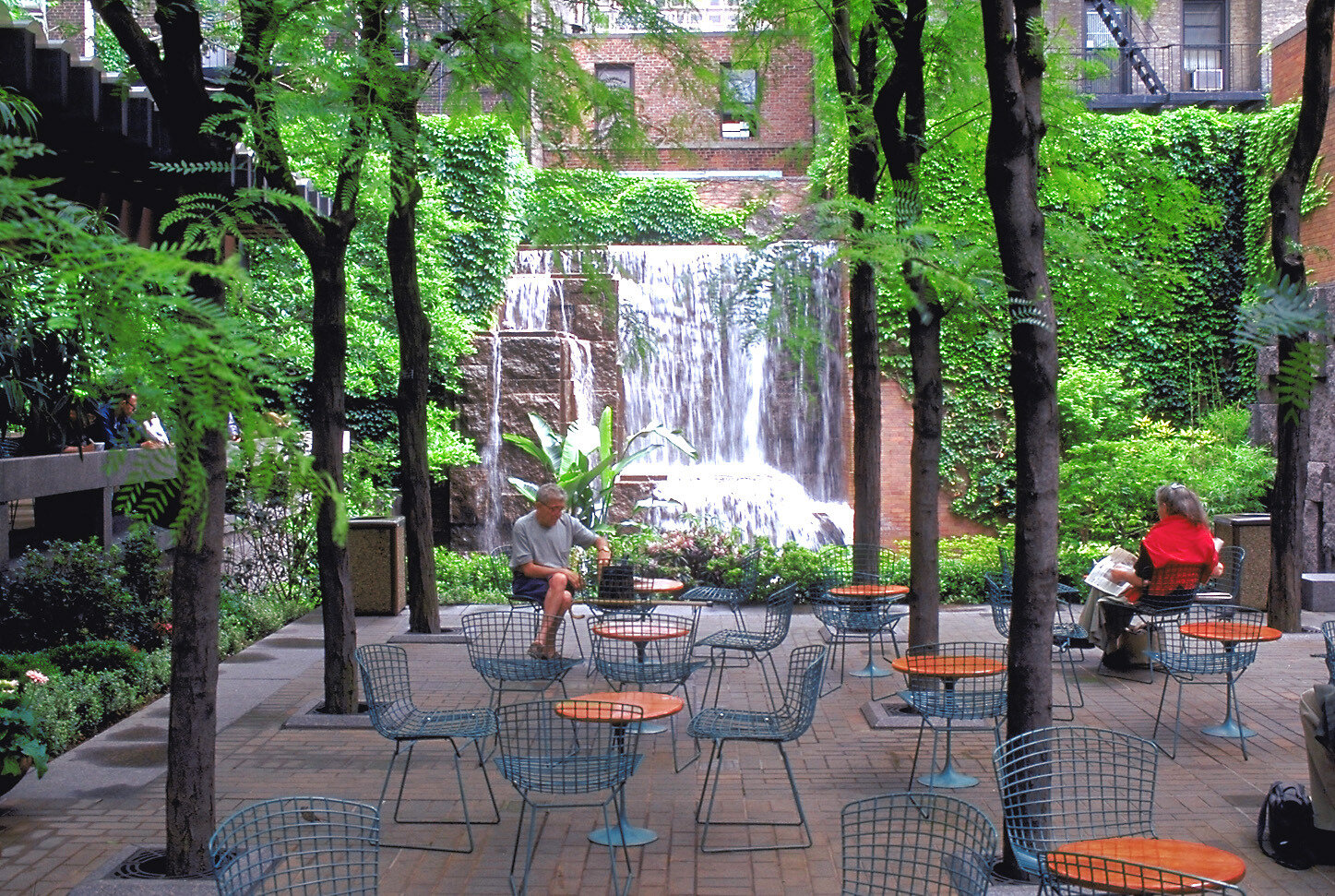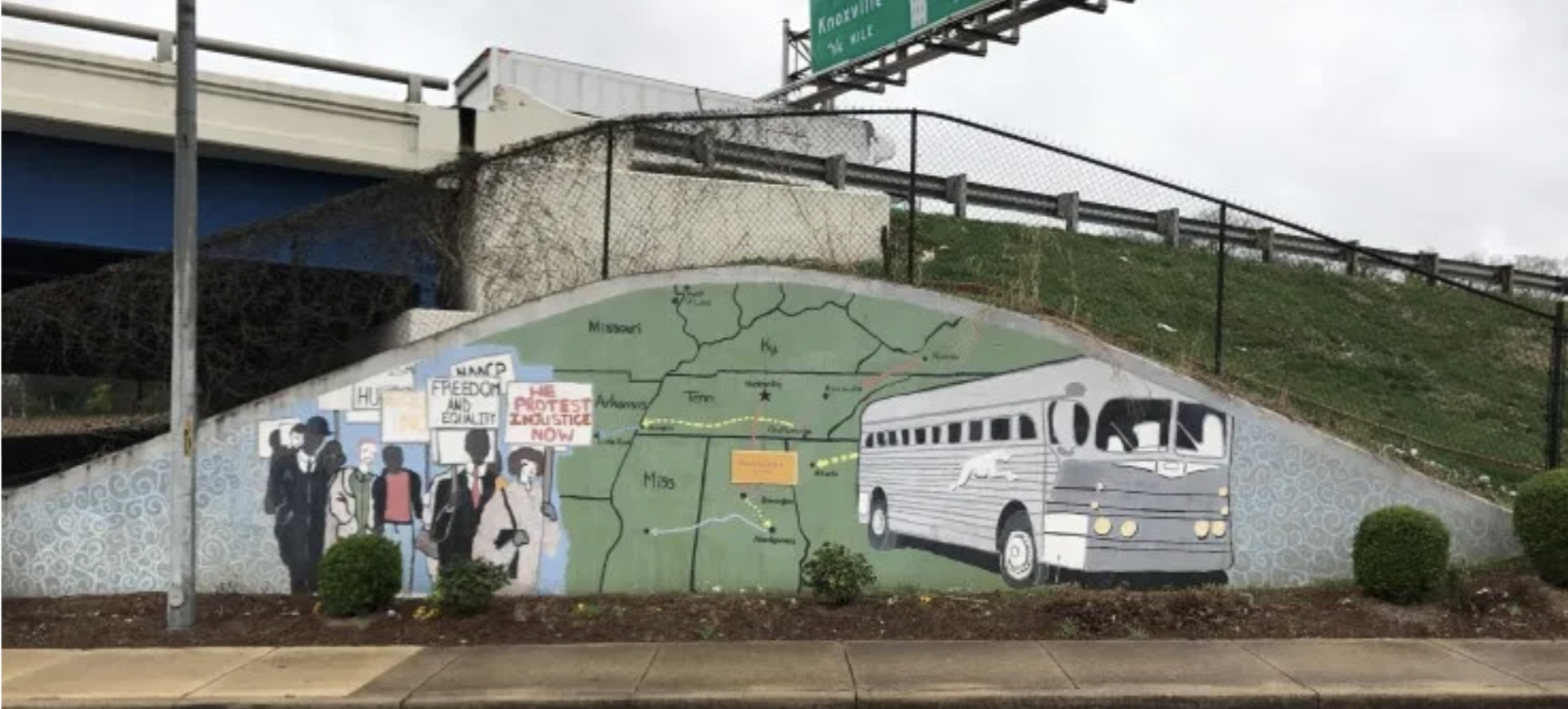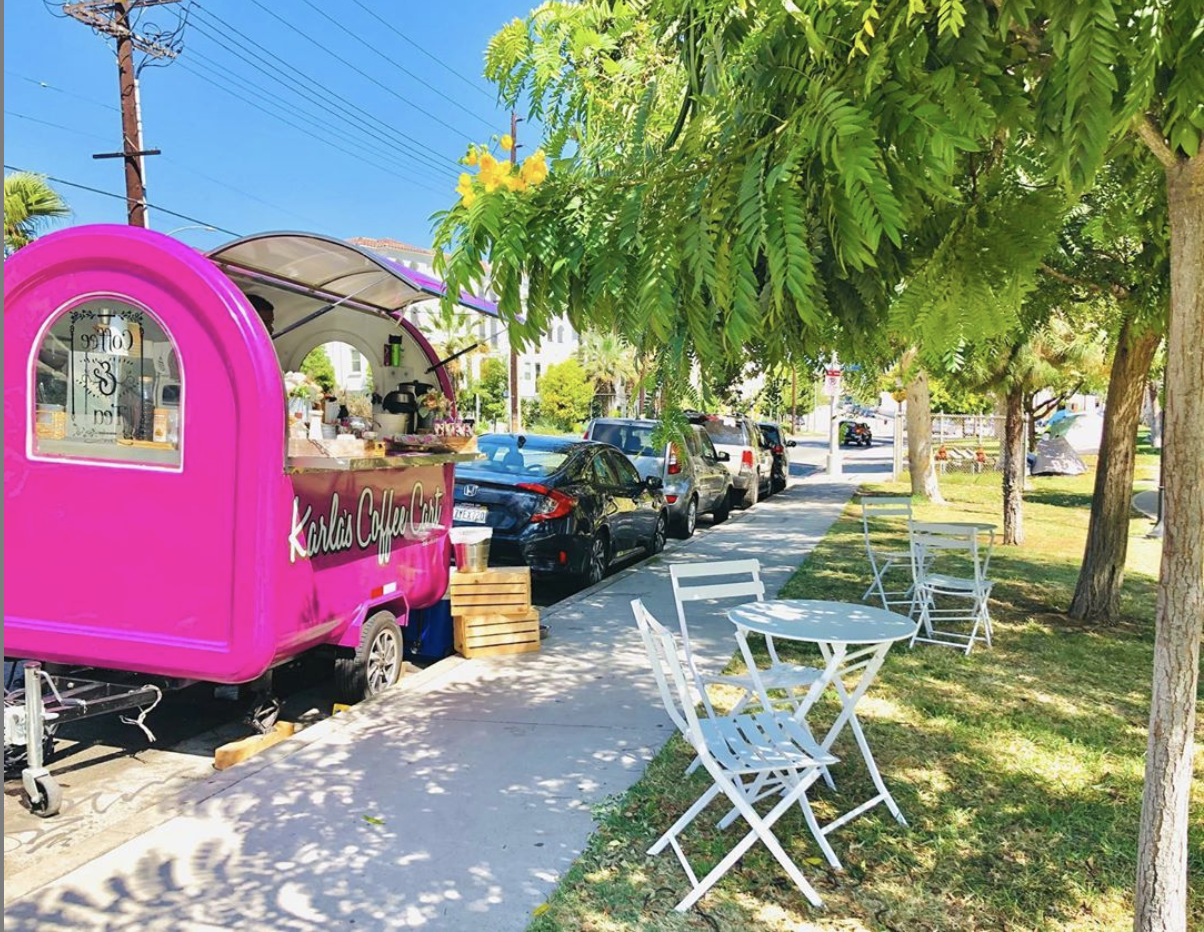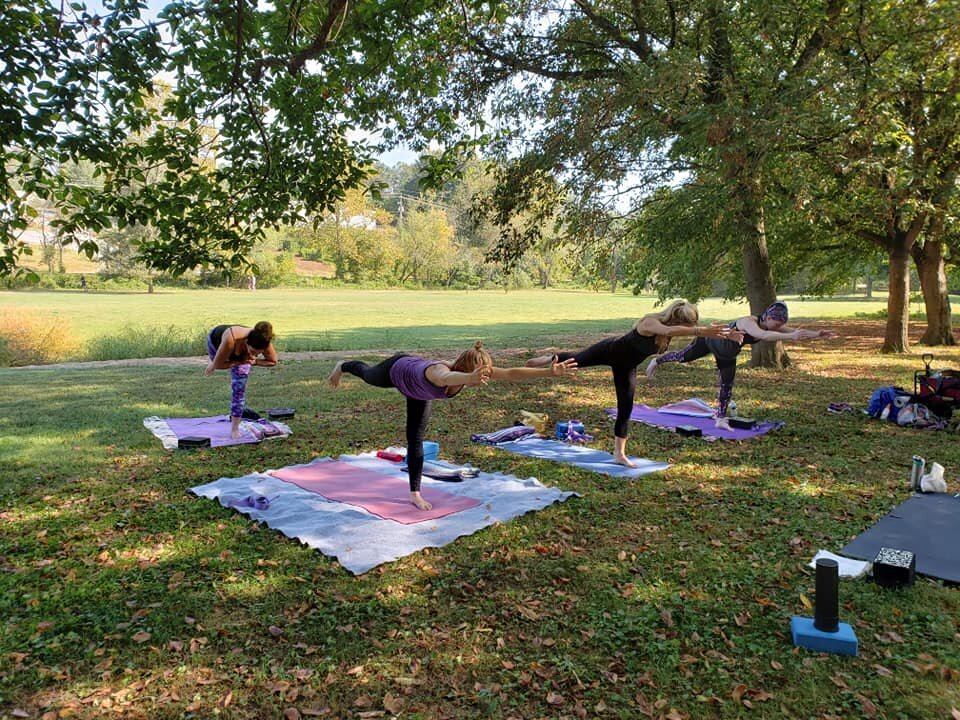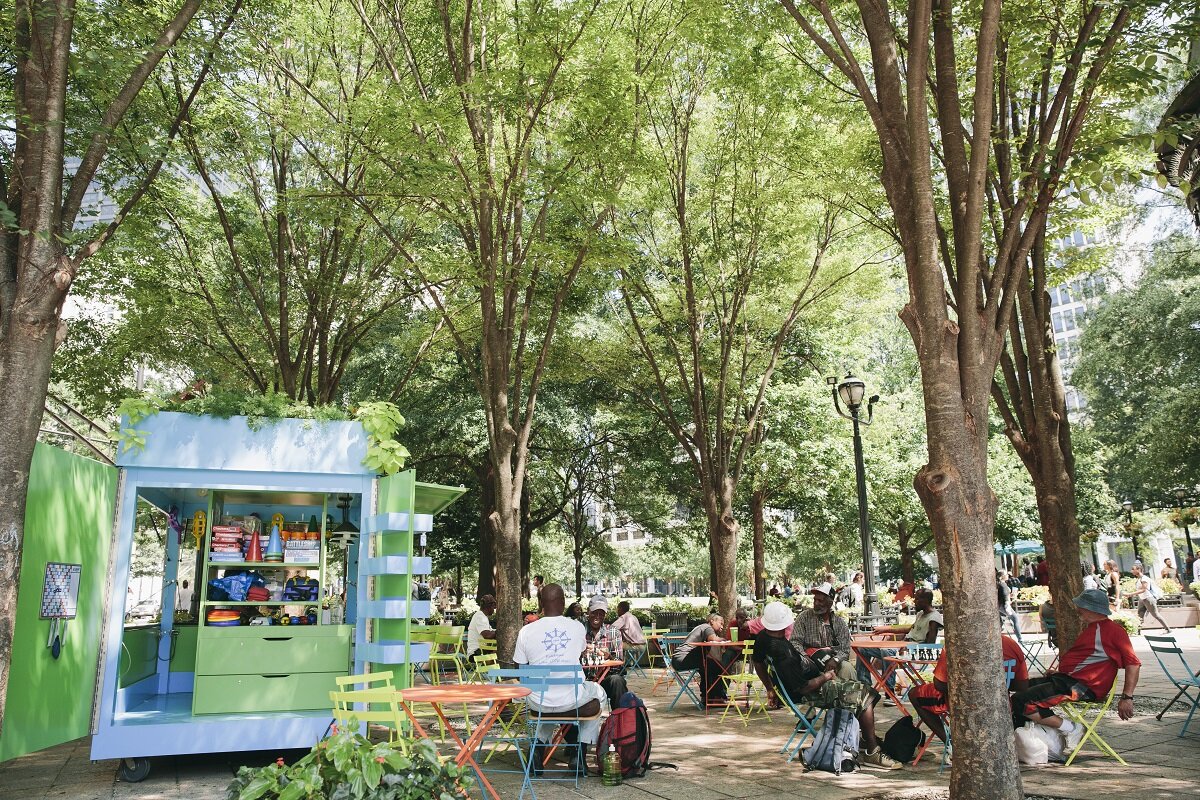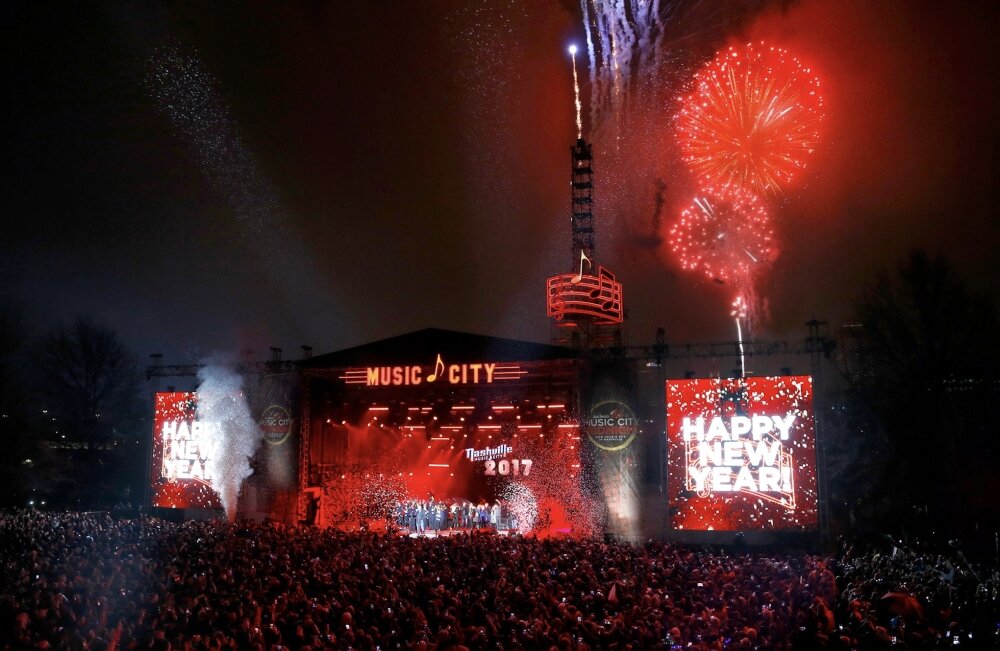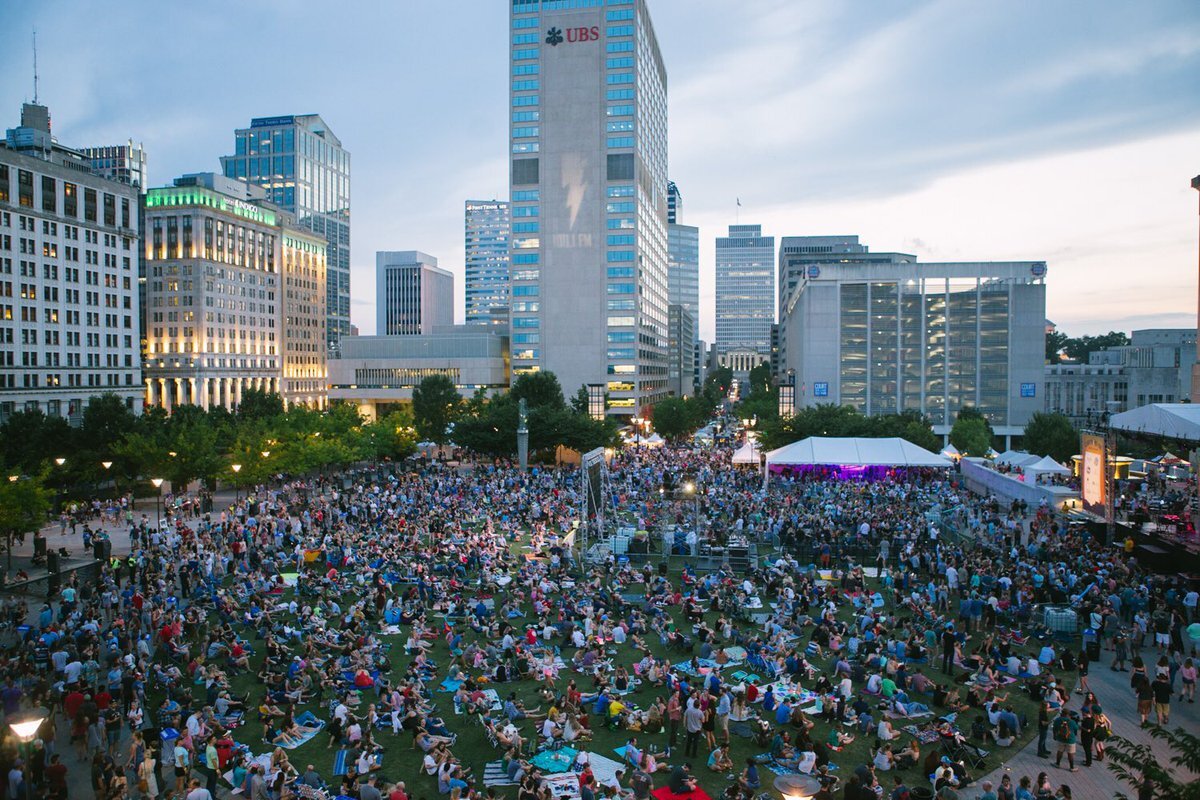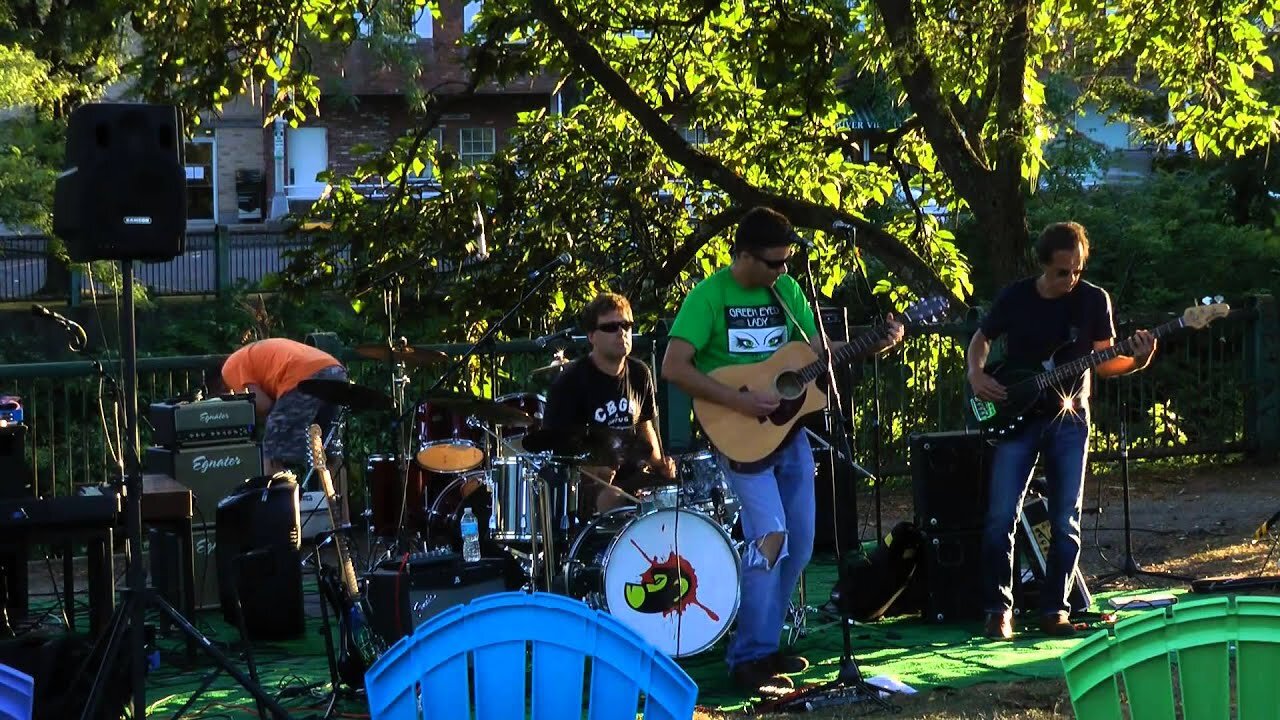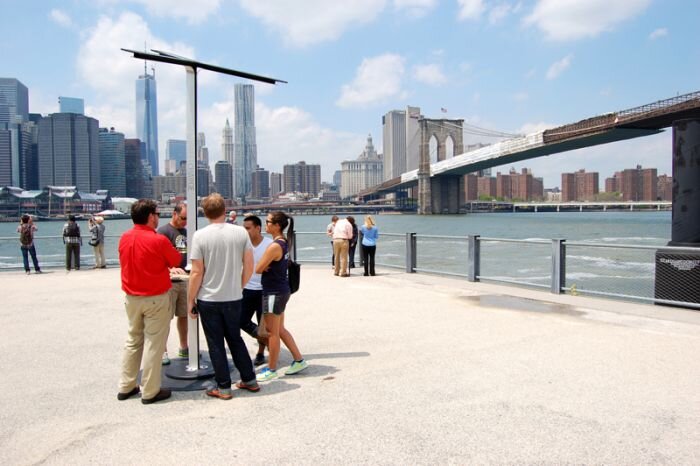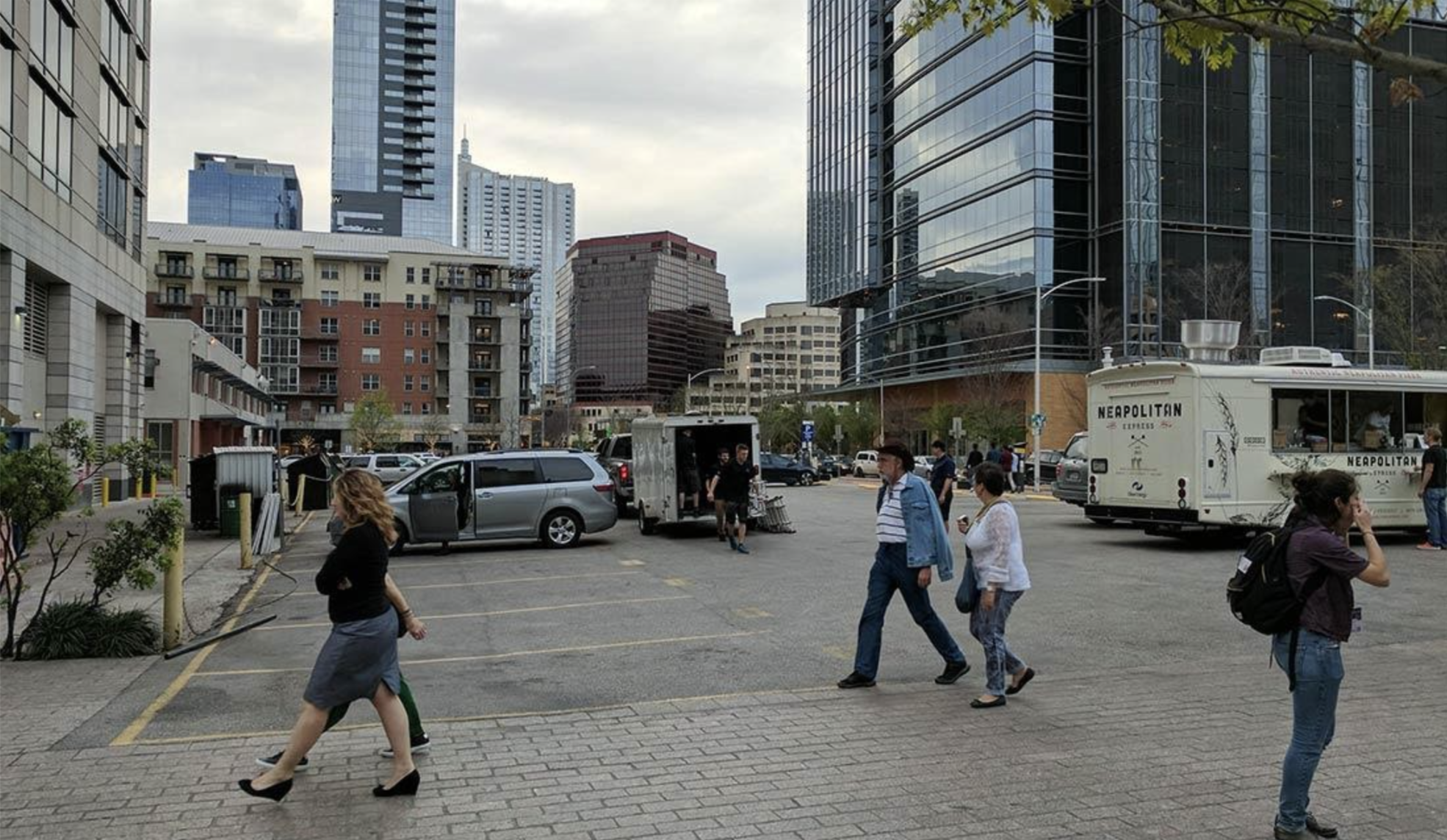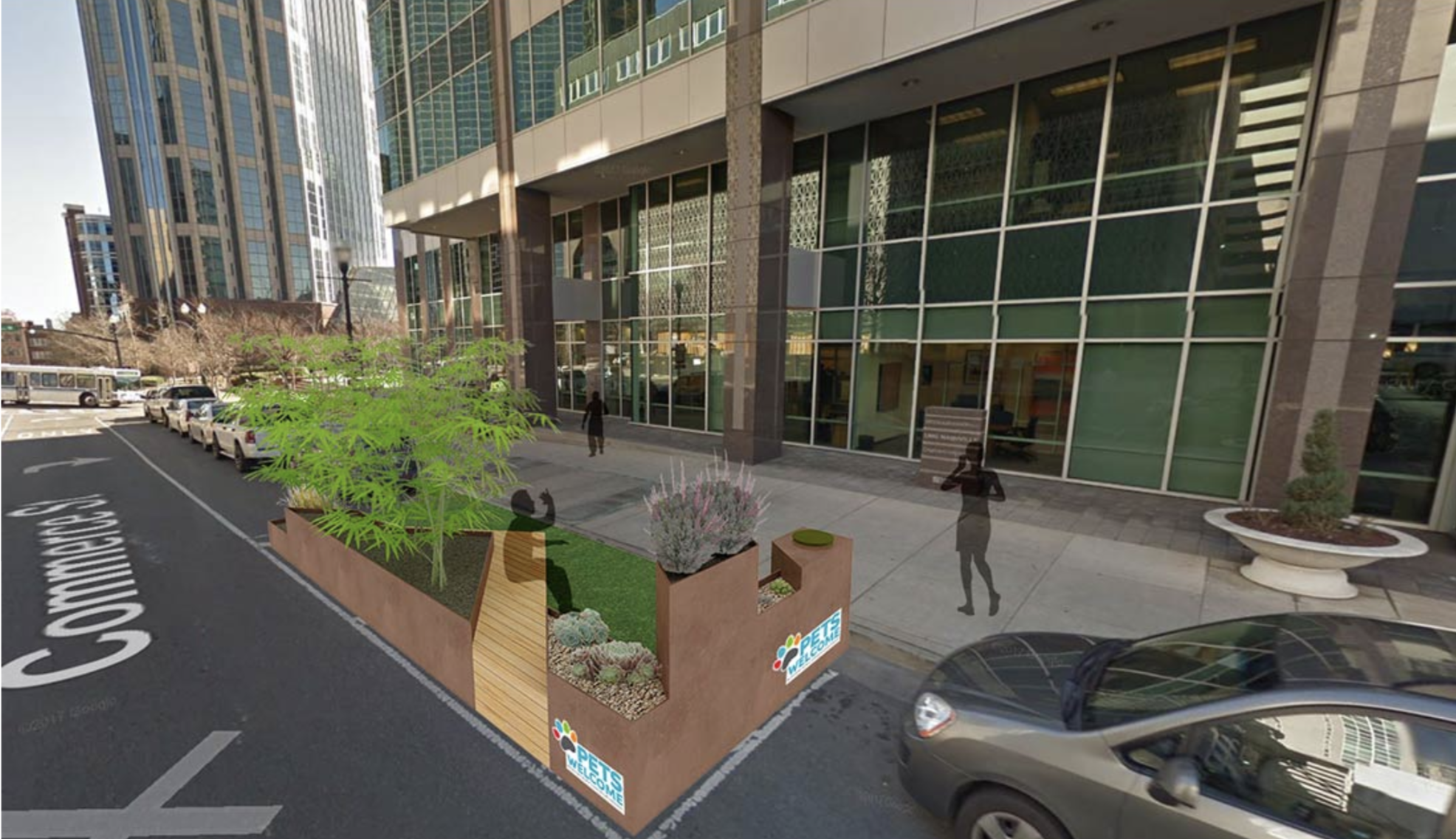Making a successful park: Church Street Park
By Megan Bennett, Research Fellow
COVID-19 has drastically altered how we use public spaces.While some spaces have adjusted their efforts to remain safe places for leisure, recreation, and socially distant gathering, the lack of public spaces in some communities have made this time more difficult for others. With commercial and social opportunities limited, public spaces are more important now than ever. As we play our part in helping our communities learn how to fix public space issues, this document highlights techniques to create equitable public spaces that can withstand time and circumstance.
“As Nashville navigates the growing pains of our changing landscape and demographics, we are asking how to make our parks and public spaces – through their design, programming and management – inviting spaces for all.”Context
Church Street Park is an 11,800 square foot underutilized space in the heart of downtown Nashville. With some intentional space activation, this rare patch of green space has the potential to be a true asset to the residents and visitors alike.
assets
Successful public spaces are typically determined not only for their individual amenities but for their surrounding environment. Church Street Park is an integral piece of the historic corridor that runs from the Tennessee State Capitol to the Metro Public Library. The corridor is home to a collection of public, government, and commercial buildings that offer visitors civic and recreational resources, and a great cultural experience while maintaining distinct Nashville characteristics.
Metro Public Library
The 300,000 sq. ft structure was designed by Robert AM Stern Architects and opened to the public in 2001. Aesthetically, the stone building’s modern classical style matches the architecture of other prominent Nashville structures such as the State Capitol and the Parthenon. Situated on the southern end of Anne Dallas Dudley boulevard and directly across from Church Street Park, the Metro Public Library offers an array of resources. The library serves as an equitable space in the city due to its accessible Wi-Fi, free computer usage, printing and it functions as a hub for community workshops and classes. The library provides one of the most affordable parking locations so visitors can get out their cars and utilize downtown’s multimodal transportation options to enjoy the nearby attractions and amenities.
Music City Central
Music City Central (MCC) is a metro transfer station that connects Nashville’s 44 local service and express service bus routes. It also is a short way away from the Music City Star, Nashville’s commuter rail that connects distant suburbs to downtown. Replacing its outdoor location in 2008, Music City Central is bordered by 4th and 5th Avenue North on Charlotte Avenue in downtown Nashville's Central Business District. Unlike its predecessor, MCC provides an inviting space with climate-controlled waiting rooms and small retail businesses. The transfer station serves up to 20,000 riders each weekday. A mere four blocks away from Church Street Park, the transfer station connects Nashville and its surrounding suburbs to the opportunities and resources of downtown.
Legislative Plaza
Located at the end of Anne Dallas Dudley Boulevard and across Union Street, the Legislative Plaza is the perfect location to connect the public to each other and the history of the city. Beneath the plaza is a collection of government offices and the Motlow Tunnel connecting to the Tennessee State Capitol. The plaza itself normally acts as an open-air space that holds public events throughout the year. Adjacent to the plaza is the War Memorial Auditorium, another venue that holds concerts and events that attract many visitors to the area. It is also a stop on many of the popular bus tours in the city. The tours and events provide the unique opportunity to engage with tourists that otherwise would not venture that way.
Hermitage Hotel
The Hermitage hotel was built in 1908 and designed to reflect Beaux-arts style architecture, making it the only example of this style in a commercial building in the entire state of Tennessee. Its location in the historic corridor, a block away from the Capitol, has caused it to be a site for many political movements in the city. Most known for its involvement in the Women’s Suffrage movement, the hotel acted as the headquarters for pro- and anti- suffrage groups. In addition to its prime location near the State Capitol for local political movements, the hotel has hosted many presidents and high-profile celebrities during their visits to Nashville. Notable past guests include former presidents Howard Taft, John F. Kennedy, Lyndon Johnson, and Richard Nixon as well as celebrities Charlie Chapman, Al Capone, Bette Davis and Greta Garbo.
Anne Dallas Dudley Boulevard
This historic road serves as a connector of the civic spaces from the library to the Capitol. Renamed in May 2017 after the Tennessee suffragist, Anne Dallas Dudley, the boulevard spans a one-block stretch between the Metro Public Library and Legislative Plaza. At first glance it is just another under-utilized side street, but the street holds a rich history. The boulevard’s namesake comes from the suffrage activist who played a huge role in giving women the right to vote in Tennessee and nationwide. In 1914, Anne Dallas Dudley Boulevard was the location of the largest women suffrage’s rally in Nashville. It also is the target for a future development project to turn the area into Anne Dallas Dudley Park. The project’s vision is to connect the historic corridor with a space that can be enjoyed by all while remaining a functioning complete street. Such development will have a large effect on the foot traffic in the area.
“Church Street Park and Anne Dallas Dudley Boulevard can become one of Nashville’s defining civic spaces – one that enhances the city around it, reflects our exceptional identity, and welcomes all into the process of navigating our future together.”The historical and public buildings listed above are important fixtures in a greater design concept known as the capital city. Similar to the City beautiful movement where planners sought to create civic virtue through monumental grandeur, the capital city concept’s aim is to strengthen the connections between the Capitol to the larger identity of the city. While creating The Plan of Nashville, a comprehensive community engagement study aimed at guiding the city’s future development, visioning workshops revealed that residents no longer felt like Nashville was a capital primarily because it no longer looked like one. The ultimate goal of the capital city concept to acts as the unifying element of the city through design and “programming to enliven the streetscape”.
Church Street Park, tucked away between the library and Anne Dallas Dudley Boulevard on the south capitol axis, provides the opportunity to play a pivotal role in activating the capital city. It is a space continuously open to the public which provides opportunities for planners and designers to employ design features that will receive interaction daily. Activating the capital city elevates Nashville’s social value by unifying the city’s visual elements that are the pride and joy for residents and visitors.
Sectional drawing showing the relationship of the Capitol, Anne Dallas Dudley Blvd, and the Main Library (Design Center 2001)
PARK ACTIVATION FEATURES
What do public spaces need to activate them? Though Church Street Park doesn’t have a lot of space to work with, it is far from the only one of its kind. There are many examples of activated, well-utilized pocket parks. While there is no singular model to ensure the success of public parks, there is a pattern to be found with effective public spaces. The key ingredients in renowned parks that have undergone positive redevelopment is 1) activation through socially conscious design and 2) programming.
Public spaces are made for people so their design should meet the needs of the people that engage with the space. Does the park provide relief from the sun and the elements? Are there flexible places for people to perch, eat a meal, or meet up with others? What attracts visitors to the park and keep them there? Currently, Church Street Park does not offer many attracting features and amenities because its design does not consider many of the previous questions. Exploring these questions can guide the activation methods necessary for making the most of public spaces within their unique contexts.
Known primarily for their reactivation work at Bryant Park in NYC, Biederman Redevelopment Ventures has created public space activation principles based on their success with Bryant Park and many others. These principles highlight the need for passive and program space by categorizing the activation elements into permanent features, core programming, and special events.
Permanent Features
Greenacre Park. New York City, New York.
Physically, permanent features act as the fixed and constant elements of public spaces. They directly reflect the intended functionality of space. Mentally to visitors, they are what they will come to expect every time they come visit the park. It is the central reason that causes people to return because they know it will be there when they do.
A simple permanent feature that leaves a positive impression to visitors is the availability of seating. This is especially important in cities with fewer than ideal places to relax. Moveable seating allows visitors more autonomy on how they use the public space and flexibility when gathering in a group. The ability to move their own seating gives visitors a sense of control that mentally communicates to them that they own parts of the park too. That they have an equal share and responsibility in the public space.
Enclosed landscape design can also provide unique solutions for shading and ensuring comfort. For example, placement of flora and shrubs create natural enclosures and put physical space between visitors and the streetscape. This type of simple solution still offers privacy and safety but is more inviting than typical gates and fences. A place where patrons can gather, enjoy a coffee, or some classic people watching in a safe, comfortable environment is a pivotal first step for successful pocket parks.
Engaging public art is another distinctive way to add character to public spaces. Nashville is a city home to many artists, singers, painters, and sculptors who have made their mark on the city so it only seems right that they should do such in Church Street Park too. While there is currently some art featured in the park, it is in the form of a mural that does not connect to the identity of the park or city as a whole. Without uplighting or a similar feature to the current mural, it has the effect of looking more weathered than its age, and public art deserves to appear appreciated in its upkeep.
1-40 underpass on Jefferson Street. Nashville, Tennessee.
History panels are a fun, interactive way to remind residents and educate visitors on just how distinct of a city Nashville really is. Also, they can provide an opportunity to commission local artists to give a city history lesson with a little more pizazz and Nashville flare.
An example of history in art is a mural of the history and commemoration of the Freedom Riders on the southwest side of the 1-40 underpass on Jefferson Street. Many Students from the three universities along the street; Fisk, Meharry Medical, and Tennessee State University were social justice advocates during the Civil Rights era. The collaboration between muralist Michael Cooper and local high school students represent the community telling their own story. The piece elevates Nashville’s rich history and engaged the community to be a part of its own activation.
Candy Chang led participatory public art project. New Orleans, Louisiana.
Core Programs
Just as important as the permanent features in public spaces is core programming in and around the space that regularly engages visitors. This element of activation is consistent and serves as the engagement piece for public space users. Core programming performs a number of functions. First, it increases the foot traffic to the space. Where someone may not want to utilize the park as a place of leisure, they may be more willing to visit for a specific social event or recreational purpose.
Karla’s Coffee Cart parked outside Echo Park. Los Angeles, California.
Food and Beverage Carts, for example, can be great additions to public spaces. While most other greenspaces in downtown Nashville are located on the outskirts, Church Street Park is fortunately situated within a collection of attractions, workspaces, and hotels in the middle of downtown. Food and beverage carts could act as a great way to increase dwell time of visitors and provide economic opportunities for local businesses.
Also, programming can provide opportunities for the park’s users to be more active. The surrounding environment has a large impact on the health and wellness of residents and visitors in cities. The Civic Design Center publication Shaping the Healthy Community: The Nashville Plan states that most residents of cities and suburbs are under-active. Exercise classes provide visitors a way to stretch a leg, encourage healthy behavior, and are fun ways to promote public interaction. Though pocket parks do not have the space for elaborate running trails and outdoor exercise equipment, they can nevertheless be creative locations for yoga and community workouts.
Community yoga classes guided by Yoga in the Park Asheville. Asheville, North Carolina.
A great example of core programming is the game cart, known as the Game Zone, in Woodruff Park of Atlanta. In 2017, the park underwent renovations that included the addition of moveable tables, chairs, umbrellas, and the distinctive Woodruff Place Game Zone. The game cart is not only the perfect excuse for the community to gather but also provides something even more valuable to its users.
Through its activation the game cart is a source of community entertainment and a great resource for users that struggles with homelessness or addiction. By collaborating with local social service agencies, the Game Zone has also been able to act as an informal resource hub to connect homeless or other locals to key resources.
Woodruff Park Game Zone. Atlanta, Georgia.
Like Woodruff Park, Church Street Park is also a location where downtown Nashville’s homeless population spend their time. As of 2019, Nashville was home to 1,986 homeless individuals. Core programs in spaces with dynamic challenges need take in account the social context of the area. The Game Zone is a great example to follow in creating engaging, inclusive programming.
Active management of the space and the presence of staff works to upkeep the day to day operations of the park as well as indirectly discourage any inappropriate or unlawful behavior. An indirect effect of having consistent programming in public spaces is increased safety and decreased criminal activity through community-based surveillance (CBS). While CBS tends to take on a more active role of reporting and responding, its most passive form of solely monitoring areas through the presence of people still makes a world of difference. In spaces that experience blight or vacancy crime tends to be more prevalent because there is no surveillance and no one engaging with the space. Activation through programming discourages would be criminal activity before it happens.
Special Events
From attracting tourist capital, providing economic opportunities for local vendors, to creating a distinctive character for a city; special events are great motivators for the public to gather. Since this element requires the most planning, they tend to happen on the less frequent basis. These events can take the form of special markets, holiday events, concerts, or festivals.
Nashville bringing in the New Year with its annual music note drop in Bicentennial Capitol Mall State Park.
Nashville is already the home of numerous festivals and concerts that define the city and attract visitors to enjoy it. Considering the size of Church Street Park, it will not be feasible to hold large scale events. However, this does not mean it is impossible to incorporate special events to activate the space. Small scale concerts and marketplaces still serve the Plan of Nashville’s goal to “invigorate Nashville’s visual identity”. Comparable to how the lighting of the Christmas tree in Rockefeller Center is just as “NYC” as the Empire State Building, city events are just as distinct as landmarks. However, there does not need to be a grand spectacle for a special event to leave its mark on a park.
Live On The Green, the free outdoor music festival hosted every summer. Nashville, TN.
Open Mic Night at Freese Park. Norwalk, Connecticut.
Modern Park Essentials
Biederman Redevelopment Venture’s approach to activation provides an excellent framework for public spaces. The approach acts as a solid foundation that all public spaces can follow but to build up a truly phenomenal park is to recognize the specific social and environment contexts of the space. Socially conscious design in a modern world understands that technology has become a necessity in users’ daily lives.
Technology
Some of the most successful public spaces have recognized the importance of incorporating technology into their design. In a 2019 study by Pew Research Center, they found that 89% percent of Americans owned a smartphone and one out of five of these users are “smartphone dependent” for internet. Meaning that smartphone dependent users utilize their phones for communication, as well as to carry out essential tasks typically done with a laptop or computer through broadband service. This is especially true for low income residents.
AT&T charging stations at Governor’s Island. New York City, New York.
Wi-Fi access and charging stations are becoming staples for equitable public spaces. In 2013, mobile charging and Wi-Fi stations began appearing in New York City parks with the AT&T Street Charge initiative. The goal of the pilot initiative was to ensure that the five boroughs of New York City each had access to free Wi-Fi and chargers for phones, tablets and other devices. Its success was made possible by the private-public collaboration between the City of New York, AT&T, Pensa and Goal Zero.
Many other parks are now adapting the SMART Park approach to public spaces. As defined by The Smart Cities Toolkit, SMART parks use technology (environmental, digital, and materials) to reflect and fit within their cultural and environmental surroundings, are easily accessible, are resilient to climate change, are water- and energy-efficient, are easy to maintain, and help promote the health and safety of communities. Technology and wireless connectivity have become an integral facet of daily life for modern park users; therefore, parks should provide the appropriate infrastructure to meet that need.
Designing with Pets in Mind
Similar to the importance of incorporating technology in modern public spaces, all park users need to be considered in the design and activation process including our four-legged friends. In the 1.2-mile radius of downtown Nashville’s core, there are approximately 5,000 dogs. It gives a whole new meaning to fur-babies considering there is a greater number of dogs than children in the area. That said, with an increase of any new population, whether bipedal or quadrupedal, it’s important that they’re taken into consideration in the public space planning process.
In an interview between Better Cities for Pets and Civic Design Center CEO Gary Gaston, Gaston stated that with more people with pets flocking to cities, the central lack of vibrant greenspace becomes more glaring. Cities can be very uninviting and challenging for pets due to the hot, rough concrete walkways and the lack of safe space for them to run around. However, that does not need to be the case. Even small pocket parks can get creative with their available greenspace to make the area more pet friendly.
Example of Pet Friendly Amenities.
Nashville is one of thirty-one cities with the Better Cities For Pet Certification, a recognition of those cities that have put programs and policies in place to make life better for their pets in addition to making them better for people. While applying pet infrastructure to parks presents obvious benefits for pets, it also has been shown to improve general public health. In the Nashville Civic Design Center’s publication “Shaping the Healthy Community”, it states effective planning for pets allows pet owners to get more exercise, get to know their neighbors, and help local businesses attract more talent with pet friendly offices. Simply put, pet-centric design leads to better, healthier communities. Pet-friendly elements such as leash attachments, water bowls, waste dispensers, and responsible pet ownership signage can enhance park spaces as an enjoyable rest stop for the two- and four-legged in public spaces.
Temporary, pop-up dog park. Austin, Texas.
A rendering of Commerce Street in downtown Nashville, with the addition of a pet-friendly parklet.
EXISTING CONDITIONS: CHURCH STREET PARK
In 2006, the Nashville Street Life Project study and survey was conducted to assess perceptions and usage of Church Street Park. This was done by observing pedestrians and patrons of the park, recording their engagement with the space at different times of the day, then administering 137 surveys to visitors of the park.
Based on observations, most pedestrians passed by or through Church Street Park as a shortcut to an adjacent street. While there is a lot of shading from trees, the only consistent available seating is the foundation in the middle of the park. Church Street Park has very few activation elements that make it an appealing local park aside the fountain and the weathered mural.
The study used the Project for Public Space (PPS) “What makes a great place?” criteria to create an index that measured the perception of the park. PPS determined that in order for a public space to be deemed a “great place” it must contain the following four qualities:
Sociability: Ability for people to see each other, meet and feel comfortable interacting with strangers
Uses & Activities: Frequency of activity in the space and availability of community resources
Access & Linkage: Connection to other physical spaces such as transit, proximity to shops, and walkability
Comfort & Image: Perceptions about safety, cleanliness, and the availability of places to sit
While Church Street Park scored a “very good” on location, it scored a “low” or “very poor” on cleanliness, good seating, signage, services and events, and safety. There are several factors responsible for the lack of park usage. However, it all boils down to the fact visitors do not want to spend time in a space that is not inviting or aesthetically pleasing, or where they do not feel relaxed.
There hasn’t been a recent follow up study to track any changes or improvements to these scores. However, 14 years later Google reviews of the park reflect similar sentiments as the study. Again, all the positive comments raved about the great location of the park and expressed enjoyment at the existence of a rare patch of greenspace in the dense metro downtown area. A recurring theme evident in the study and still apparent today, is that the space lacks intentional, consistent activation which fails to create an inviting space that all users can utilize and enjoy. Fortunately, many community organizations, advocacy groups, and public entities have taken notice of the hidden gem that is Church Street Park and the great potential it holds if some of the activation features identified in previous sections are employed.
Public spaces, in their most basic form, are intended to be places for the community to gather. If they fail to serve that purpose, it denies the public the social, economic, and even health benefits associated with parks. In metro areas where public greenspace is in short supply, spaces like Church Street Park are even more important to preserve and activate.
ACTIVATION IN ACTION
Using research and exploring what works in similar spaces is crucial to making informed decisions on how to refresh public spaces. The Civic Design Center has supported the activation by publishing numerous documents, renderings and recommendations on how to improve upon Church Street Park’s current state. One such publication is a three-part series called Dreaming Big for Public Space that digs into some alternative approaches for how to innovate Church Street Park.
Church Street Park has all the core ingredients to be a successful, well-utilized public space but needs the activation to push it out of stagnation. While there are plenty of examples of beautifully designed public spaces shown in the series, public spaces, no matter how aesthetically pleasing, tend to fail due to lack of funding, management, and continual use. Dreaming Big for Public Space highlights case studies where partnership played a key role in redeveloping other parks. Activations of the parks will not only influence the singular public space but the resources and businesses around them. In the case with Bryant Park, its redevelopment increased the property value of surrounding land plots and grew the customer base for local businesses. Collaborating with local businesses and community groups that are also stakeholders in the park through private-public partnerships or sponsorships would be a great start to Church Street Park’s activation and help ensure its long term, sustainable success.
While partnerships are excellent ways to secure funds, the activation of public spaces doesn’t need to be a massive financial undertaking. The Civic Design Center’s Reclaiming Public Space work uses pop-up installations to make permanent change in the public spaces through tactical urbanism which provides a simple, affordable way to test out park features and design elements for the risk adverse. Tactical urbanism allows the flexibility for spaces to transition quickly and affordably while collecting quick feedback from users to determine how effective amenities are to them.
Public spaces do not need to be complex or expensive. Most users are looking for somewhere safe and beautiful where they can relax away from the hustle and bustle of cities. Church Street Park is no exception.



